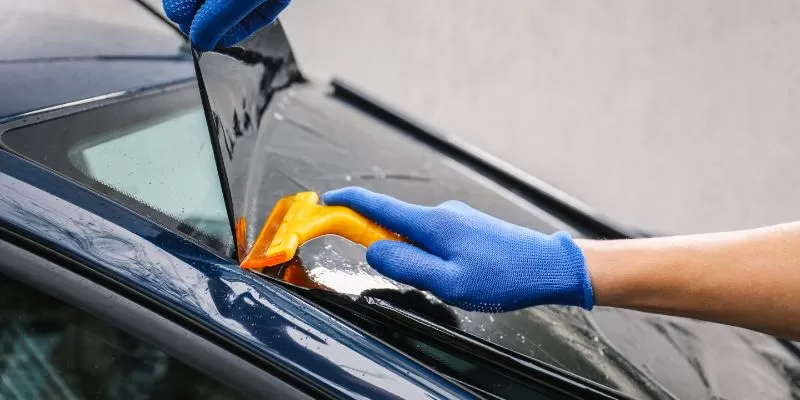Car Window Tinting: Tips for Keeping a Specialist Complete
Car Window Tinting: Tips for Keeping a Specialist Complete
Blog Article
Home Window Tinting Regulations and Guidelines: What You Required to Know Before Tinting Your Auto
Prior to waging window tinting for your vehicle, it is vital to familiarize on your own with the varied laws and guidelines that control this method across different states. These policies determine the acceptable degrees of color darkness, often determined by visible light transmission (VLT) percents, and include details stipulations for front windscreens targeted at guaranteeing road safety and security. In addition, certain jurisdictions may supply medical exceptions for individuals with certifying conditions. Recognizing these complexities can conserve you from possible lawful ramifications, but what are the specific policies in your state?
Overview of Window Tinting Regulations
Home window tinting regulations are frequently subject to variation across various jurisdictions, mirroring neighborhood regulations and safety factors to consider. These regulations dictate the permitted levels of color darkness and reflectiveness on car windows, ensuring that chauffeurs maintain appropriate visibility while likewise protecting against unsafe UV rays and warmth.
A lot of guidelines classify home window tinting based upon the Visible Light Transmission (VLT) percentage, which suggests the quantity of light that can pass via the window. Typically, reduced VLT portions signify darker tints. Legislations usually set apart in between the front, side, and back windows, with stricter restrictions put on the front windshield to enhance safety and security for both the motorist and various other road customers.
Compliance with window tinting guidelines is crucial, as infractions can result in penalties, necessary removal of the tint, and possible boosts in insurance coverage premiums. It is important for car proprietors to acquaint themselves with regional regulations before proceeding with window tinting setups.
State-by-State Color Laws
Understanding the particular window tinting laws in each state is crucial for vehicle owners looking for to abide with the legislation. Each state in the united state has actually developed its own set of policies regulating home window tinting, which can differ significantly. These policies typically determine the allowed levels of color darkness, the sorts of windows that can be tinted, and any clinical exceptions that may apply.
For instance, states like California have rigorous constraints on tint darkness for front home windows, while others, such as New Mexico, might allow darker tints. In addition, certain states mandate details visibility percentages for numerous home windows, including the windshield, front side home windows, and rear home windows. It is important for auto owners to acquaint themselves with their state's legislations to prevent possible fines or charges.
Furthermore, some states might call for an accreditation sticker to be put on tinted home windows, indicating compliance with state regulations. Failure to stick to these regulations not just risks legal repercussions but can additionally affect safety and security and presence while driving. As a result, vehicle proprietors must conduct extensive study or get in touch with local authorities to make sure full understanding and compliance with state-by-state color regulations.
Allowed Tint Kinds and degrees
Several vehicle proprietors might be stunned to find out that allowed color levels and types differ extensively across various states. Each state has developed its own laws concerning the allowable darkness have a peek here and reflectivity of window color, commonly determined by Visible Light Transmission (VLT) percentages. VLT refers to the amount of light that can travel through the colored home windows; therefore, a reduced portion indicates a darker color.

Additionally, the kinds of color materials enabled can differ, with some states restricting metallic or mirror-like surfaces. It is vital for vehicle proprietors to familiarize themselves with their state's certain laws to make sure compliance. Non-compliance can lead to fines, mandatory removal of the color, or other lawful effects, making it important to comprehend these policies navigate to this website before proceeding with setup.
Medical Exceptions for Tinting
While not all states give allocations for clinical exceptions concerning home window tinting, those that do identify the need for details individuals to boost presence and comfort as a result of clinical problems. Numerous medical conditions, such as lupus, skin cancer, and specific eye conditions, can make people particularly conscious sunlight. These people might require darker colors to shield themselves from harmful UV rays and glare.

It is important to note that despite having a clinical exception, there may still be restrictions on the degree of tint permitted. Compliance with state legislations makes certain that people are both secured and within legal limits. Those taking into consideration medical exemptions need to call their neighborhood Department of Electric motor Automobiles or equal authority to recognize the procedures and demands required to obtain an exemption properly.
Penalties for Non-Compliance
Failing to follow window tinting regulations can lead to considerable penalties, which vary by state. Police are encouraged to provide citations for lorries that do not comply with the specified tinting guidelines. These penalties usually consist of fines, which can range from moderate total up to several hundred dollars, depending upon the intensity of the offense and the state concerned.
In some territories, repeated offenses might cause rising fines or additional fines, such as necessary court appearances. In addition, non-compliance might necessitate the removal of illegal tinting, usually at the owner's cost. In severe instances, regular transgressors might encounter suspension of their automobile registration until compliance is accomplished.
Additionally, insurance coverage implications might arise from getting multiple citations for window tint offenses. Insurance companies may view such infractions as a sign of riskier behavior, potentially bring about boosted costs or trouble in coverage.
To stay clear of these fines, it is critical for vehicle owners to familiarize themselves with their local window tinting laws and make certain that their automobile complies (Window Tinting). This aggressive technique not only avoids legal ramifications but also advertises roadway security
Verdict

Most regulations classify window tinting based on the Visible Light Transmission (VLT) percentage, which suggests the quantity of light that can pass with the home window. Compliance with home window tinting regulations is critical, as offenses can result in penalties, necessary elimination of the color, and potential boosts in insurance coverage costs.Understanding the details window tinting policies in official source each state is vital for car owners looking for to abide with the law. These regulations commonly dictate the permitted degrees of tint darkness, the kinds of windows that can be tinted, and any type of medical exemptions that may apply.
For circumstances, states like The golden state have stringent constraints on tint darkness for front home windows, while others, such as New Mexico, may allow darker colors.
Report this page